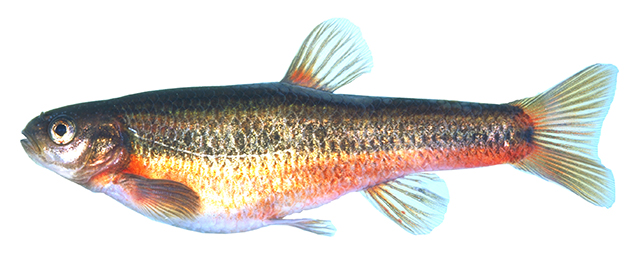| Leuciscidae (Minnows), subfamily: Plagopterinae |
| 7.8 cm TL (male/unsexed) |
|
demersal; freshwater |
| North America: middle Cumberland (mostly Caney Fork) and Tennessee River drainages in Tennessee, Georgia, and Alabama, USA; Kelley Creek (Coosa River system) in Alabama. |
|
Anal soft rays: 7-8. Hemitremia flammea can be distinguished by having the following characters: caudal peduncle deep; head short; snout extremely short; mouth small, slightly subterminal; eye round; body barely compressed; dorsal fin origin slightly behind pelvic fin origin; lateral line incomplete, fewer than half of scales pored; 38-44 lateral scales; anal fin with 7-8 rays; pharyngeal teeth 2,5-4,2; and coloration consists of olive above, dark stripe along back, dark streaks along upper side, followed by light stripe, then black stripe ending at black caudal spot or wedge, white to red below, bright scarlet red along bottom 1/3 of body and at base of dorsal fin in large specimens (especially males), and silver peritoneum flecked with black (Ref. 86798). |
| Occurs in springs and spring-fed streams, usually over gravel (Ref. 5723, 86798). Feeds on midge larvae supplemented with isopods, oligochaetes, hemipterans, and snails (Ref. 10294). |
|
Near Threatened (NT); Date assessed: 13 February 2012 Ref. (130435)
|
| harmless |
Source and more info: www.fishbase.org. For personal, classroom, and other internal use only. Not for publication.

